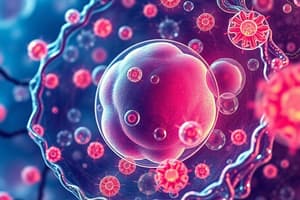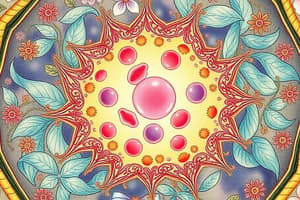Podcast
Questions and Answers
Loose connective tissue - under the ______
Loose connective tissue - under the ______
skin
Adipose tissue - fat droplets; cell ______
Adipose tissue - fat droplets; cell ______
nucleus
Blood - RBC, WBC, ______
Blood - RBC, WBC, ______
Plasma
Fibrous connective tissue - cell ______; collagen fibers
Fibrous connective tissue - cell ______; collagen fibers
Cartilage - ______, matrix
Cartilage - ______, matrix
Bone - central canal, matrix, ______
Bone - central canal, matrix, ______
Skeletal muscle - ______; fibers; attached to and pull on bones; striated; multinucleated; leg
Skeletal muscle - ______; fibers; attached to and pull on bones; striated; multinucleated; leg
Smooth muscle - involuntary; fibers; non-striated; spindle shaped, uninucleated; internal ______
Smooth muscle - involuntary; fibers; non-striated; spindle shaped, uninucleated; internal ______
Cardiac muscle - involuntary; fibers; striated; branched; uninucleated; intercalated discs; ______
Cardiac muscle - involuntary; fibers; striated; branched; uninucleated; intercalated discs; ______
Nervous Tissue - Brain, spinal cord, and nerves - Main tissue of nervous ______
Nervous Tissue - Brain, spinal cord, and nerves - Main tissue of nervous ______
Flashcards are hidden until you start studying
Study Notes
Science and Scientific Method
- Science comes from the Latin word "scientia," meaning knowledge
- Scientific method is used to verify facts, investigate phenomena, and discover knowledge
- Steps of the scientific method:
- Observation: noticing something unusual
- Identification of the problem: asking questions (what, why, how)
- Hypothesis: an educated guess or tentative answer
- Experimentation: testing the hypothesis
- Conclusion: the final answer to the problem
Microscopes
- Types of microscopes:
- Simple microscope (single lens; Anton van Leeuwenhoek)
- Simple compound microscope (2 sets of lenses)
- Laboratory compound microscope (developed by Robert Hooke; with oil lamps)
- Modern compound microscope (with more than 1 lens; has 3 to 5 objective lenses)
- Electron microscope (uses electrons, not lenses)
- Microscopic terms:
- Magnification: ratio of the size of an object seen under the microscope
- Resolving power: ability of the microscope to differentiate 2 close points as separate
- Working distance: between the objective and the objective slide
- Numerical aperture: ratio of the diameter of the lens to its focal length
Parts of the Microscope
- Mechanical parts:
- Arm: connects the upper and lower parts of the microscope
- Base: serves as the 'foot'
- Stage: where the slide is placed
- Stage clips: hold the slide
- Draw tube: holds the eyepiece
- Body tube: allows distance between the eyepiece and objective lens
- Dust shield: protects the objective lenses
- Revolving nosepiece: allows shifting of the objective lenses
- Coarse adjustment knob: large adjustment focus; object into focus
- Fine adjustment knob: small adjustment focus; image into focus
- Illuminating parts:
- Mirror: gathers light
- Lamp: source of light
- Diaphragm: regulates the amount of light
- Condenser: concentrates light to the specimen
- Optical parts:
- Eyepiece/Ocular: lens on top of the microscope; secondary image
- Objective lenses: primary image; LPO, HPO, OIO (Low Power Objective: 10x, High Power Objective: 40x, Oil Immersion Objective: 100x)
Cytology and Histology
- Cell: basic unit of life that performs all life processes
- Organelles: basic cell parts that perform physiological activities
- Cell membrane (plasma membrane): separates the cell from its external environment
- Cytoplasm: inside of the cell
- Nucleus: contains genetic material for the cell
- Ribosomes: small complex proteins that assemble proteins from mRNA; not surrounded by membrane
- Golgi apparatus: packages proteins into membrane-bound vesicles
- Endoplasmic reticulum: synthesizes cellular materials (smooth and rough endoplasmic reticulum)
- Nucleolus: substructure of nucleus that synthesizes ribosomal RNA
- Mitochondria: powerhouse of the cell
- Vacuoles: empty 'bags' within the cell; storage bubbles found in cells
- Vesicles: packages of cell membrane
- Cytoskeleton: scaffolding of tubes providing internal support for the cell
- Flagella/Cilia/Pili: protein filaments that allow cells to move
- Cell wall: cellulose structure supporting the cell
- Chloroplasts: photosynthesizing organelles
- Central vacuole: large water-filled sac in the middle of plant cells
- Lysosomes: structure containing enzymes that break down unwanted materials; tiny sac
- Centrosomes: organelle containing centrioles
Cellular Processes
- Active transport: movement against the concentration gradient using energy (ATP)
- Passive transport: movement along the concentration gradient without energy
- Isotonic solution: no net movement of water
- Hypotonic solution: water enters the cell
- Hypertonic solution: water leaves the cell
Cell Cycle
- Interphase: preparatory stage for cell division; cell is resting
- G1: organelles are duplicating
- G0: quiescent stage
- S phase: DNA replication
- G2: protein synthesis
- Mitosis: somatic cell division; diploid (2n)
- Stages of Mitosis:
- Prophase: chromosomes are duplicated
- Metaphase: chromosomes are at the metaphase plate
- Anaphase: daughter chromosomes are moving toward the pole of the spindle
- Telophase: chromosomes will become distinct chromatin
- Meiosis: gamete cell division; haploid (n)
Cell Shapes
- Squamous cells: tile-like cells
- Cuboidal cells: cube-like cells
- Columnar cells: tube-like cells
- Stellate cells: star-like cells
- Amorphous cells: irregular shape
- Oval cells: round cells
- Fusiform cells: spindle-like cells
- Polygonal cells: many-sided cells
- Thread-like cells: flagellated cells
- Spider-like cells: bone matrix formation cells
Epithelium Tissue
- Types of epithelium:
- Squamous: thin and flat cells
- Cuboidal: short cylindrical cells
- Columnar: long or column-like cylindrical cells
- Layers:
- Simple: one layer of cells
- Stratified: two or more than two layers of cells
- Pseudostratified: similar to columnar epithelium but all cells are not of similar height
- Examples of epithelial tissues:
- Simple squamous: air sacs of the lung, blood, lymphatic vessels, and heart
- Simple cuboidal: kidney, ovaries, lungs
- Simple columnar: intestine/digestive tract, gallbladder
- Pseudostratified ciliated columnar: respiratory tract, nasal cavities, sinuses, auditory tubes, trachea, bronchi
- Stratified squamous: esophagus, skin, throat
- Stratified cuboidal: ducts of glands, ovarian follicles
- Stratified columnar: urethra, pharynx, larynx
- Transitional: urinary bladder, ureters, urethra
Connective Tissue
- A type of tissue that provides support and structure to the body
Studying That Suits You
Use AI to generate personalized quizzes and flashcards to suit your learning preferences.




